Contents
ABSTRACT
Global population growth has led to a rise in food consumption, placing increasing pressure on the agriculture sector to meet this demand. Despite advances in technology, smallholder farmers continue to face financial challenges. Researchers studied farmers’ entrepreneurship to address this issue and boost farmers’ income. This systematic literature review aims to comprehensively examine the existing body of research about the domain of farmers’ entrepreneurship. The review used the PRISMA method to collect the requisite data from reputable database sources, including Scopus and the Web of Science. The study primarily focused on 82 open-access research papers in scholarly journals. A bibliometric analysis was conducted to explore content and network patterns, followed by a thematic analysis of the selected papers. The findings present the application of various entrepreneurial theories in agriculture, highlighting the interplay between farmers’ internal traits (intention, resourcefulness) and external factors (market, technology, policy). The reviewed papers employed a range of advanced analytical techniques. It also found that entrepreneurial traits help farmers respond to market changes and customer needs. Additionally, these traits help them adopt soil-specific farming strategies, new seed varieties and technical developments in agricultural operations. Entrepreneurial policies mostly favor large-scale and professional farmers. However, smallholder farmers struggle to capitalize on entrepreneurial opportunities. The review highlights a gap in the literature regarding the entrepreneurial mindset, knowledge and aspirations of farmers and the impact of government support and existing facilities on smallholder farmer sustainable entrepreneurship. Future research should focus on understanding the enabling factors that help farmers adapt and thrive in the evolving agricultural landscape.
INTRODUCTION
In recent years, the significance of entrepreneurship to national prosperity, technological advancement and employment growth has gained widespread recognition.[1,2] Due to rising unemployment, entrepreneurial activity is at an all-time high.[3] Entrepreneurship encourages economic sectors to be more innovative and adaptable to global changes. Entrepreneurial activities have become a key strategy for improving farmers’ income, as innovation in farming practices enables them to enhance productivity, diversify their operations and respond to market demands more effectively.[4] Thus, entrepreneurship in agriculture increases farmer’s income. This shift towards entrepreneurship in farming is not only important for individual financial growth but also plays a critical role in the broader agricultural sector’s ability to adapt to institutional, economic and technological changes.[5]
The existing reviews on agricultural entrepreneurship have several gaps (Table 1). They predominantly focus on isolated factors like gender, incentives, or the role of returning farmers, which overlook the broader and more integrated challenges faced by farmers.[6–8] Furthermore, few publications employed systematic review methodologies and the PRISMA framework, which could facilitate a more thorough and comprehensive examination.[9] The reviews also fail to address the entrepreneurial traits of farmers and their direct impact on agricultural activities. Furthermore, the existing reviews neglects some concepts like technology adoption, environmental sustainability and policy frameworks in shaping farmers’ entrepreneurship.[6–11]
| Sl. No. | Reviews | Method | Review Focus | Types of articles considered for the review | Number of Papers | Year Range |
|---|---|---|---|---|---|---|
| 1 | Jonathan et al., (2017) | Not Specified | Entrepreneurial Development | Not specified | Not Specified | Not specified |
| 2 | Dias et al., (2019) | Systematic | Entrepreneurship in Agriculture | Articles from Scopus Index on Agricultural Entrepreneurship | 272 | 1969-2012 and 2013-2017 |
| 3 | Yoon et al., (2021) | Not Specified | Agricultural Innovation | Not specified | Not specified | Not specified |
| 4 | Nulleshi and Tillmar (2022) | The systematic literature review | Rural entrepreneurship | Entrepreneurship studies and rural studies, through the concept of rural proofing | 97 | 1989-2020 |
| 5 | Zu et al., (2022) | Overall research approach | Land Resources, Rural Entrepreneurship | Land Resources, Rural Entrepreneurship | Not specified | Not specified |
| 6 | Zhang et al., (2023) | Overall Research Approach | Diffusion process and poverty reduction effect of returning farmers ‘entrepreneurship | Three entrepreneurial diffusion projects | Not specified | Not specified |
This study is especially opportune and pertinent, as it will offer a comprehensive, evidence-based understanding of the entrepreneurial landscape of farmers, which is critical in the face of ongoing global challenges. Recent trends, such as the increasing need for sustainable farming practices, the growing adoption of technology and the effects of climate change on agricultural productivity, make it essential to explore how farmers’ entrepreneurial traits impact their business success and adaptability. Moreover, the integration of bibliometric analysis with data from reputable databases such as Scopus and Web of Science (WoS), focusing exclusively on open-access papers, guarantees a thorough, transparent and current assessment of the field. By addressing gaps in research on farmer entrepreneurial traits and their broader implications, the review will specifically analyze various aspects, including the year-wise distribution of studies, publication source and country distribution, frequently used keywords, three-field diagrams, conceptual structure maps and thematic maps. These analyses are crucial for understanding the broader trends in agricultural entrepreneurship, as they provide insights into how research on farmers’ entrepreneurial traits has evolved over time, which regions and sources are contributing most to the field and which topics are being prioritized. The three-field diagram is used to visualize the relationships between the authors, countries and publications, while conceptual structure maps help to identify how different concepts are connected within the literature. Additionally, thematic maps will offer a deeper understanding of the key research areas and their development, allowing researchers to identify both well-established topics and emerging trends. This analysis will provide a comprehensive, structured overview of the field and highlight critical areas that require further investigation. The PRISMA approach is vital for conducting systematic literature reviews as it ensures a rigorous and reproducible method for synthesizing research. By using structured frameworks like the TCCM (Theories, Characteristics, Contexts and Methods), PRISMA enhances clarity and depth, facilitating the identification of research gaps and future directions.[12] Such structured reviews are essential for evaluating current knowledge in a specific field, offering a reliable basis for further study. This approach is particularly beneficial in business and non-business domains, ensuring comprehensive and scientifically sound reviews.
LITERATURE REVIEW
Farmers
Role in Food Security
Global agriculture must adapt in the coming decades to meet the food demands of a growing, increasingly affluent and urbanized population. Smallholder farmers, who account for 80% of farms globally, are critical to achieving food security.[13] Their contribution is particularly significant in developing regions, where they produce 50-70% of the food supply.[14,15] However, smallholders often operate under challenging conditions, including limited access to land, markets and modern technology, resulting in lower productivity compared to large-scale farms.[7,16,17] Addressing these challenges is pivotal for improving global food security and nutrition.
Economic Challenges
Smallholder farmers face economic challenges that limit their productivity and resilience. Restricted access to profitable markets reduces income potential, while volatile input prices create financial instability, hindering effective planning.[18,19] Inadequate financial systems further restrict access to credit, stalling investments in productivity-enhancing tools.[20] Diversifying income sources and adopting entrepreneurial strategies can mitigate these issues. Activities like livestock rearing enhance financial security,[21] while sustainable practices and modern technologies, such as the Internet of Things (IoT) and Artificial Intelligence (AI), reduce costs and increase yields.[18,19]
Role of Digital Technology
Recent studies emphasize the transformative potential of digital technology for smallholders. For instance, mobile technology has facilitated access to market information, credit and extension services, enabling farmers to improve productivity and resilience.[16,18–20] However, barriers such as low digital literacy and uneven access to infrastructure persist, limiting the widespread adoption of these tools.[15]
Entrepreneurship
Defining Agricultural Entrepreneurship
Agricultural entrepreneurship, or agripreneurship, plays a transformative role in rural economies by fostering job creation, particularly among youth, through small business development in agriculture and related sectors.[16,22] It drives economic growth by enhancing incomes through value addition and innovative practices.[23] Agripreneurs contribute significantly to food security by adopting sustainable practices that minimize environmental degradation and improve food production and distribution systems.[22,24] However, challenges like limited access to finance, inadequate training and weak market linkages persist.[25] Supportive policies and education can mitigate these barriers, enhancing agripreneurship’s impact.[24]
Barriers to Entrepreneurship
Despite its potential, agripreneurship faces several barriers, including limited access to education, credit and markets.[18,19] For instance, smallholders in Sub-Saharan Africa report challenges in securing loans due to lack of collateral, which restricts their ability to scale entrepreneurial ventures.[26] Overcoming these barriers requires integrated approaches, including policy interventions and capacity-building initiatives.
Role of Education and Training
Education and training are pivotal in enhancing entrepreneurship among farmers by equipping them with essential skills and knowledge. For instance, targeted programs such as YESS in Indonesia develop business capabilities that significantly boost productivity and promote sustainable agricultural practices.[16,27] Moreover, training focused on local resource utilization fosters innovation, enabling farmers to create marketable products and effectively adapt to market demands.[16,27] Additionally, agricultural vocational training and technology integration enhance entrepreneurial intentions and competencies, including risk-taking and collaboration.[28] However, addressing barriers like resource access is crucial to maximizing these programs’ potential impact.
The existing literature reviews highlight the growing importance of entrepreneurship in addressing agricultural challenges and enhancing farmers’ livelihoods. It underscores the role of smallholders in global food security and identifies entrepreneurship as a new approach to improving farmers’ incomes, adopting innovative practices and responding to market demands.[6,8,11] Besides, existing review tends to focus on broad agricultural challenges or specific issues like market access, with limited exploration of the entrepreneurial traits unique to farmers.[21] Theoretical frameworks like the Theory of Planned Behavior and entrepreneurial event theory have been applied in agri-entrepreneurship but lack comprehensive integration into studies on farmer entrepreneurship.
The current systematic review addresses these gaps by employing a bibliometric and systematic literature review focused explicitly on farmers’ entrepreneurial traits. By analyzing trends, keyword relationships and thematic maps, it aims to provide a structured understanding of key factors influencing farmer entrepreneurship, identifying both well-established areas and emerging themes. This research will contribute to the field by offering a holistic perspective way for future studies to build on its findings.
MATERIALS AND METHODS
Data collection
The Preferred Reporting Items for Systematic Reviews and Meta-Analyses (PRISMA) procedure was used to gather the necessary data for this systematic literature review. Adhering to PRISMA guidelines is essential for generating reliable and comprehensive evidence in scientific research due to its quality in reporting systematic literature reviews by ensuring transparency. It enhances methodological rigor, offers a clear structure and helps minimize biases, thus promoting reproducibility.[29]
Search strategy
The data required for this analysis was obtained from SCOPUS and WoS databases due to their comprehensive coverage, citation indexing and high-quality, peer-reviewed content across diverse disciplines. The following search terms were used in the search string: “Article title, Keywords and Abstract”: “Entrepreneurial*” OR “Entrepreneurship” AND “Smallholder farmers” OR “farmers” OR “Peasant” OR “Cultivator”. This study wanted to know all of the potential research work that has been done on smallholder farmers and farmers’ entrepreneurship (such as entrepreneurial attitude, entrepreneurial self-efficacy, inventiveness, entrepreneurial intention, etc.) and using the search string “entrepreneurial*” helped to identify all of the many traits of entrepreneurship.
Search criteria
The PRISMA statement was used as the foundation for the selection of criteria.[30] The primary objective of the search was to create a map of the available research on smallholder farmer entrepreneurship in agriculture. The selection criteria were open access, journal paper, research article and all countries. Based on the inclusion criteria, this review covered studies from 2006 to December 2023.
Data extraction
During the data extraction period, 1444 results were obtained from SCOPUS and 400 results from WoS. The inclusion criteria used were open-access journals and articles written in English and the exclusion criteria were all non-open access, conference proceedings, articles in the press, other languages, reviews, book chapters and books. Using these inclusion criteria, 1056 research papers in SCOPUS and 120 in WoS were excluded. After screening, 388 publications were exported from SCOPUS and 280 from WoS, then merged using RStudio and removed 194 duplicates. To ensure the high quality of the study, each article’s title and abstract were checked and studies unrelated to farmers and entrepreneurship was not included. In the end, for the comprehensive literature study, 82 papers were utilized and that were directly relevant to farmers engaging in entrepreneurship. Including non-open access papers in SLR is difficult due to restricted availability, limited access and licensing barriers, hindering comprehensive inclusion and analysis. Hence, this SLR considers only open-access articles, ensuring wider accessibility, transparency and reproducibility.
Quality assessment
A quality assessment was conducted based on the search string used to collect the papers. Only research papers published in academic journals were included in this study. To ensure the literature used in the review was relevant and of high quality, the titles of the papers were carefully reviewed for analysis and refinement. Each paper was then thoroughly read to select only those that specifically focused on farmer entrepreneurial traits and where the factors were well specified. In the end, 82 articles were chosen based on how well they met the inclusion criteria and their relevance to the topic.
Data analysis
The RStudio program, known for its versatility in data visualization and bibliometric analysis,[31] was selected for this study due to its ability to seamlessly integrate data from multiple databases. It features a robust duplicate-removal function that screens all paper details, not just titles, ensuring comprehensive deduplication. The ‘biblioshiny’ package enhances RStudio’s functionality by automatically generating bibliometric outputs, including network, thematic and conceptual mappings, with customizable settings for specific analysis factors. The TCCM approach was employed to structure the discussion of the included papers. This systematic process begins by identifying theories and analyzing their context for easy grouping. Followed by characteristics such as dependent, independent, mediating and moderating variables are identified and their relationships are visualized in a flowchart. Finally, the methodology, sample size and analysis techniques are reviewed to comprehensively overview the research methods used. The PRISMA approach is presented in Figure 1.
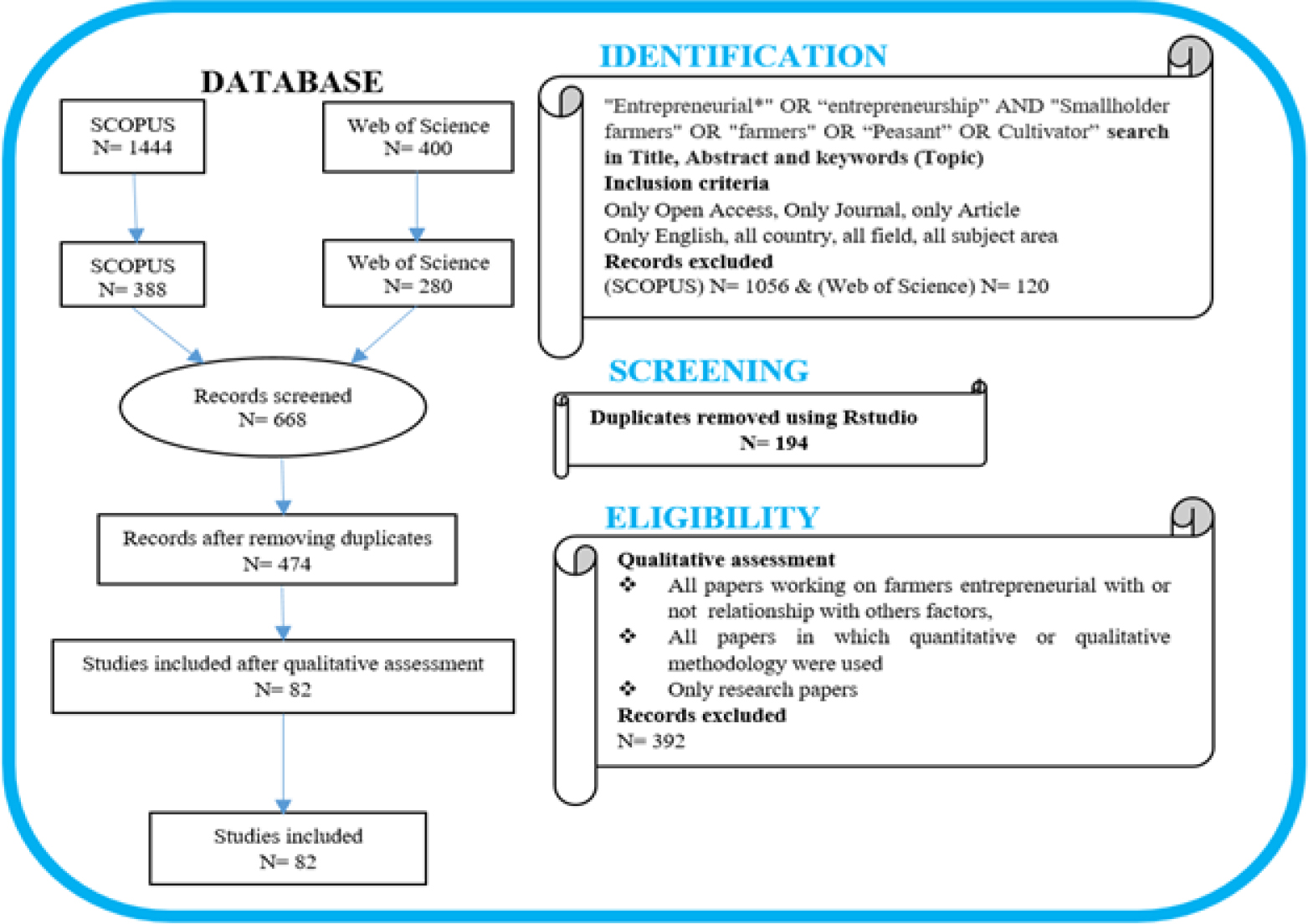
Figure 1:
Schematic diagram of identification and extraction of the data for the study following PRISMA guidelines. Source: Author’s compilation (2024).
RESULTS AND DISCUSSION
Bibliometric analysis
Overview
The general information of the reviews of farmers’ entrepreneurship analyzed in RStudio is presented in Figure 2. The articles published from 2006 to 2023 were included in the analysis. This evaluation includes 82 papers from 51 publications with a 14.5% annual growth rate. Only 5 of the 257 authors worked alone. International co-authors made up 12.2% of the total, averaging 3.62 per paper, demonstrating an interest in the topic. The number of keywords used was 285 and 2894 references were utilized. The average age of the document is 3.57 years. The average number of citations per document is 6.22. This reflects the topic is of current interest to many. The high citation rate shows the quality.

Figure 2:
General information of the studies reviewed. Source: Author’s compilation (2024).
The distribution of research papers included in the review over the year by citation through bibliometric analysis is presented in Figure 3.

Figure 3:
Distribution of the study over the year. Source: Author’s compilation (2024).
Figure 3 shows that the research was conducted between 2006 and 2023. A total of 40 research studies were published in 2022 and 2023. The number of studies conducted increased from 2021 to 2023 (n=52). This indicates the recent importance of entrepreneurship in the agricultural sector.
The three-field plot showing the relation between journals, authors and countries is depicted in Figure 4.
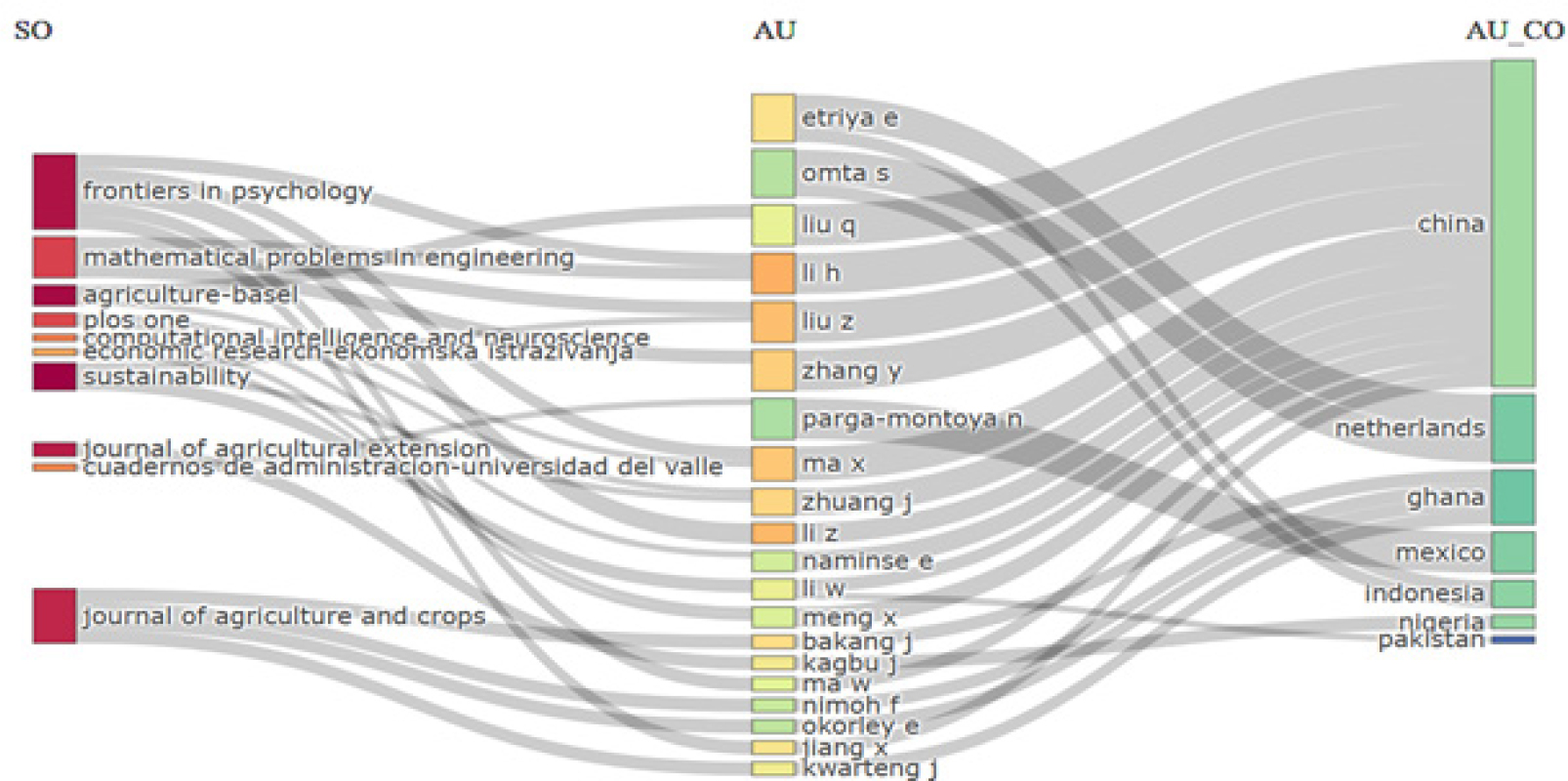
Figure 4:
Three-field plot analysis showing the relationship between journal, authors and country. Source: Author’s compilation (2024). SO: Source of publication; AU: Authors; AU_CO: Author’s Countries.
The results of the analysis of the three fields plot based on the Sankey diagram explain the relationship between three different pieces of information.[32] Figure 4 shows the three-field plots of visualizing the connection that exists between the journal, author and country. The number of locations in colored rectangular nodes determines their height.
The line width between these nodes is proportional to connections. For example, the source “Frontiers in Psychology” possesses a large node, indicating numerous author relationships and contributions. The relationship strengthens with line thickness.[33] In the Figure 4, 10 journals are enumerated under the first variable (SO). The Frontiers in Psychology has published a larger number of articles (n=5) on this list. These 5 investigations were conducted by 5 distinct authors Ma; Jiang; Li; Liu; Ma X.[34–36] All of them are from China. Regarding the countries associated with the third variable (AU_CO), those with the greatest linkage power were discovered to be from China with 12 different authors combined into 7 journals. It is also observed that 4 different authors (Bakang J, Nimoh F, okorley E and Kwarteng J) were linked by Journal of Agriculture Crops.
The analysis of author production
Blue color represents collaboration within a specific country; the red color symbolizes collaboration encompassing multiple countries in Figure 5.
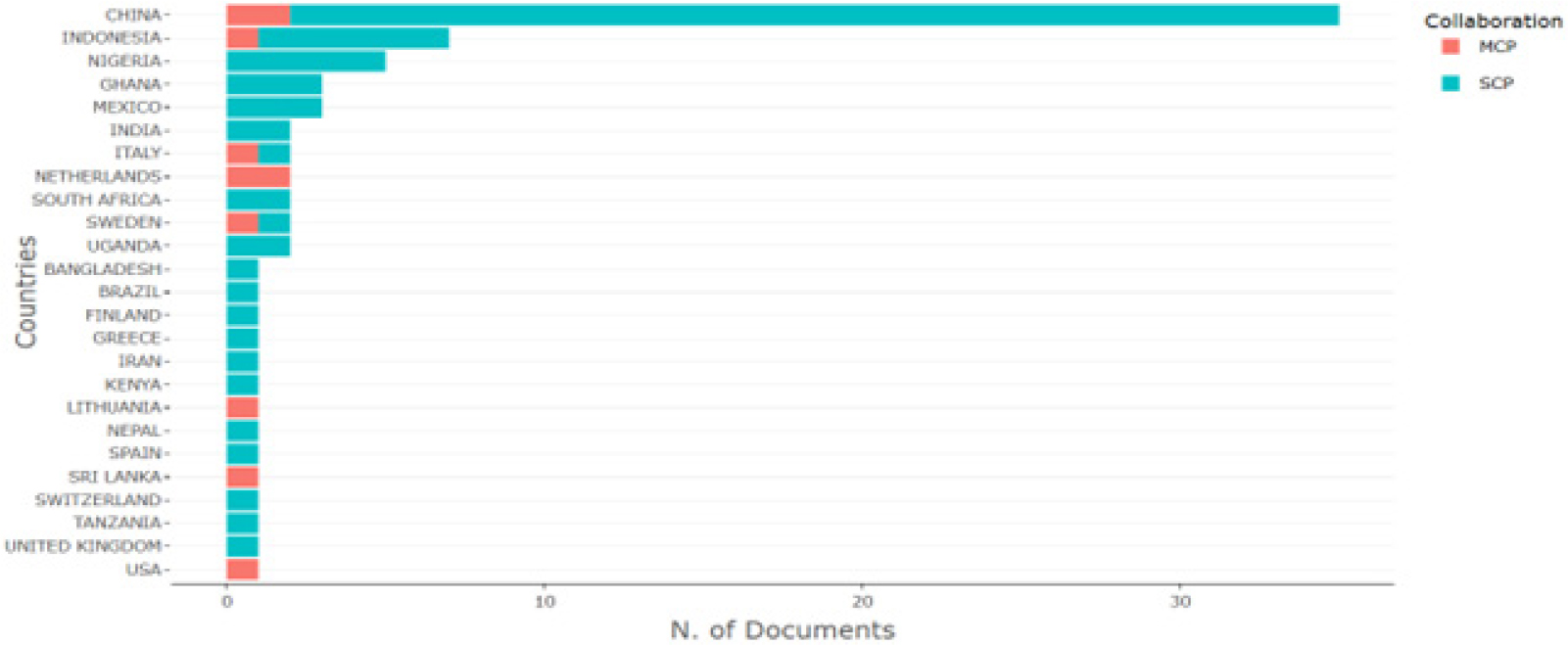
Figure 5:
Corresponding Author’s countries. Source: Author’s compilation (2024). SCP = Single country publication; MCP= Multiple countries publication.
Chinese corresponding authors have engaged in two international paper collaborations out of the 35 papers published, whereas the Netherlands only partakes in two paper collaborations with international counterparts. Corresponding authors from Indonesia, Italy, Sweden, Lithuania, Sri Lanka and the United States each contribute to one publication involving international collaboration.
The blue color on the map (Figure 6) shows the country in which the studies were conducted. The lower density of the blue color is explained by less research work on farmers’ entrepreneurship in countries such as Bangladesh, Finland, Greece, India, South Africa, Sir Lanka, Sweden, Switzerland and Tanzania and this could be due to the lack of agripreneurship.[37] reported that low and middle-income countries face many challenges in producing research papers. However, there are international collaborations, which explains the awakening of researchers to the question of the entrepreneurial spirit of small farmers as found by[38] that international collaboration has the potential to improve publication productivity and boost the quality of research. Research works were most widely conducted in China (12), followed by Indonesia (4), Mexico (3), Nigeria (3) and the United States (2).
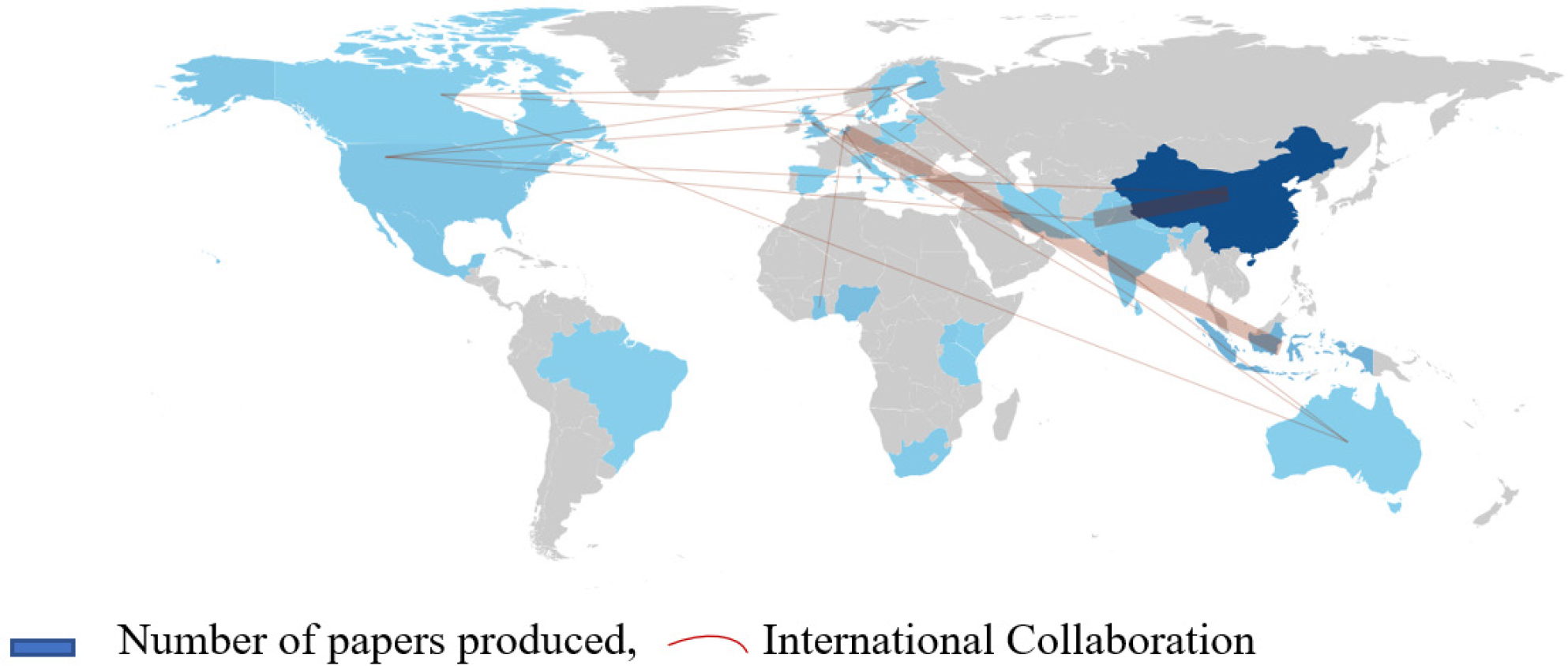
Figure 6:
Map of the distribution of the papers produced by countries and international collaboration. Source: Author’s compilation (2024).
The content and network analysis
The content analysis investigated the most prevalent author’s keywords used in the research papers. Co-occurrence analysis was carried out on keywords provided by the authors. Figure 7 illustrates three primary clusters, each of which is interconnected. The blue cluster represents the social capital of farmers, while the red cluster corresponds to their entrepreneurial orientation and the purple cluster depicts their entrepreneurial performance. Additionally, the Figure reveals three smaller clusters that are not interconnected. The interconnectivity among the author’s keywords is minimal due to the novelty of entrepreneurship in the agricultural domain.
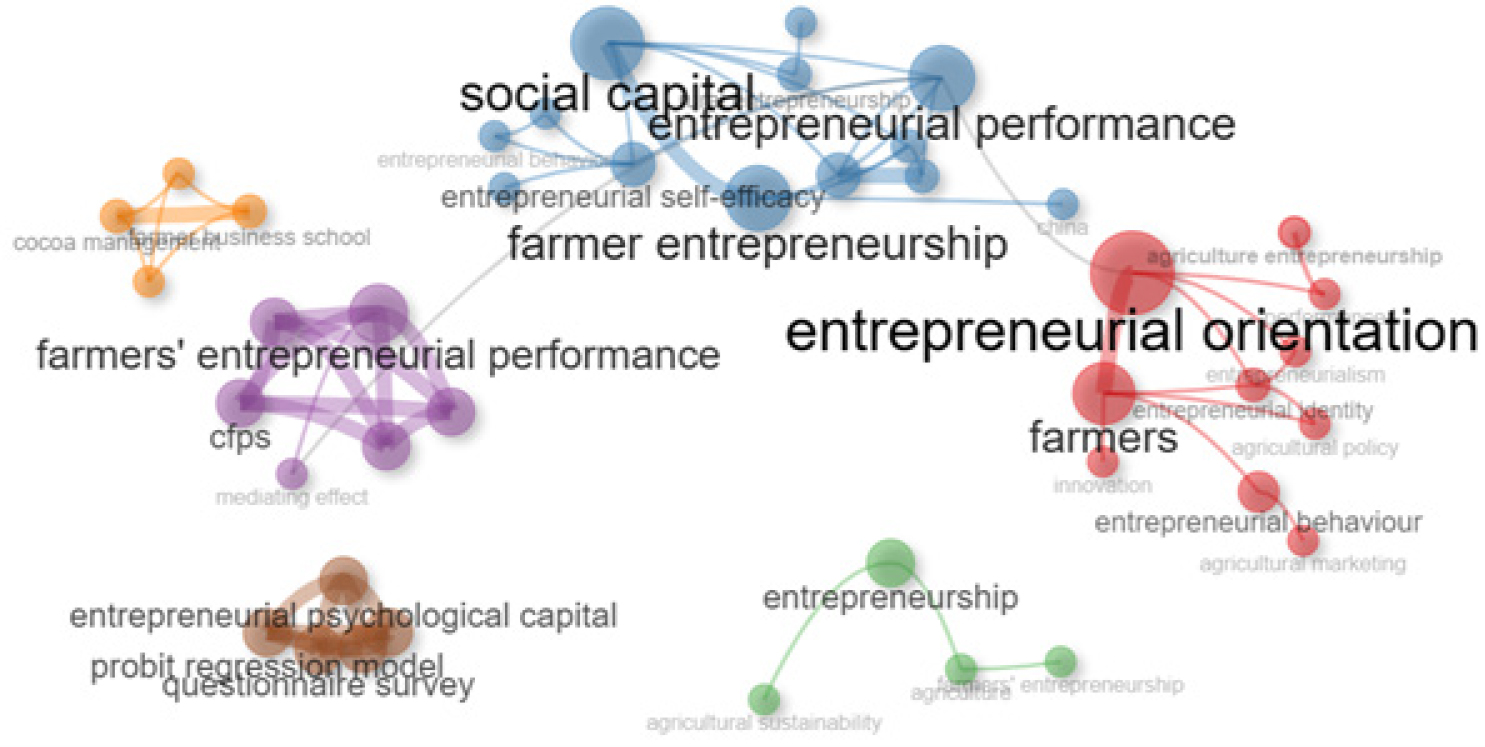
Figure 7:
The co-occurrence network of author’s keywords. Source: Author’s compilation (2024).
Figure 7 confirms that the studies were focused on farmers and the most identifiable keyword is entrepreneurial orientation, then entrepreneurial performance, social capital etc. Some of the key areas, like farmers’ entrepreneurial mindset and intention, are lacking. Figure 7 shows a red cluster indicating similar keywords different authors have used and the keywords are also close to each other on the map since they are similar (10 keywords, shown that some of them listed as entrepreneurial orientation, communication network, business tie, entrepreneurial competencies, etc.). It also shows two clusters on each side of the red cluster, blue and green; the keywords are far from the commonly similar keywords.
The connections reveal that farmer entrepreneurship is shaped by social capital, entrepreneurial orientation and measurable performance. Social networks and collaboration empower farmers, while innovation and proactive behaviors drive success. Performance reflects economic gains and sustainability. Smaller clusters on psychological capital and sustainability highlight emerging areas. The limited overlap indicates the novelty of this research, suggesting opportunities to integrate relationships, mindset and measurable impacts for advancing entrepreneurship in agriculture.
Figure 8 presents 4 clusters of co-citations between authors. The co-citation analysis displays the associations between articles. The most interconnected cluster is the red, followed by the blue and the green. Co-citation occurs when a third article cites two other articles. The relationship between the two articles is strengthened when additional articles also cite them. Moreover, a larger co-citation circle indicates a greater number of citations received by an article. The distance between two articles signifies the connection between journals, specifically the number of journals that simultaneously cite both publications.[39]

Figure 8:
The co-citation among publications. Source: Author’s compilation (2024).
Systematic analysis
The systematic literature review was conducted using the TCCM framework and thematic analysis to identify key points from the included papers. The results are presented graphically, with appropriate interpretations provided to enhance understanding of the research conducted in the field of farmers’ entrepreneurship.
The Theories and Context analysis
Theories
The mapping of theories collected from papers included in this review highlights various direct and indirect links to farmers’ entrepreneurial behavior. The entrepreneurial trait theory connects experiences of disaster shock to entrepreneurial impulses by examining psychological and cognitive aspects.[34,40] Behavioral and process-oriented theories, such as the theory of planned behavior, emphasize the role of entrepreneurial self-efficacy.[41] Resource and capability-based theories, like the resource-based theory and entrepreneurial bricolage, show how digital literacy and resourcefulness enhance entrepreneurial performance.[42] Theories of identity and motivation indicate that diversified farmers experience higher work well-being.[43]
Technological and cognitive theories, such as the technology acceptance model, demonstrate the impact of education, farm size and government support on technology adoption.[44] Social and structural theories, like the structural holes theory, explain how farmers succeed by strategically positioning themselves in market networks.[45] Resource dependency theory and the theory of dynamic capability underscore the importance of training, digital technologies and networking.[46,47]
Applying these theories in studying farmers’ entrepreneurship provides valuable insights into enhancing farmers’ capabilities, fostering innovation and improving market participation. For instance, understanding the entrepreneurial trait theory can help develop targeted support programs post-disaster, while leveraging digital literacy can boost rural entrepreneurial performance.[48] These insights have significant implications for policy-making, training programs and support mechanisms to empower farmers and foster rural economic development.[48] The concept map of the compiled theories is shown in Figure 9.
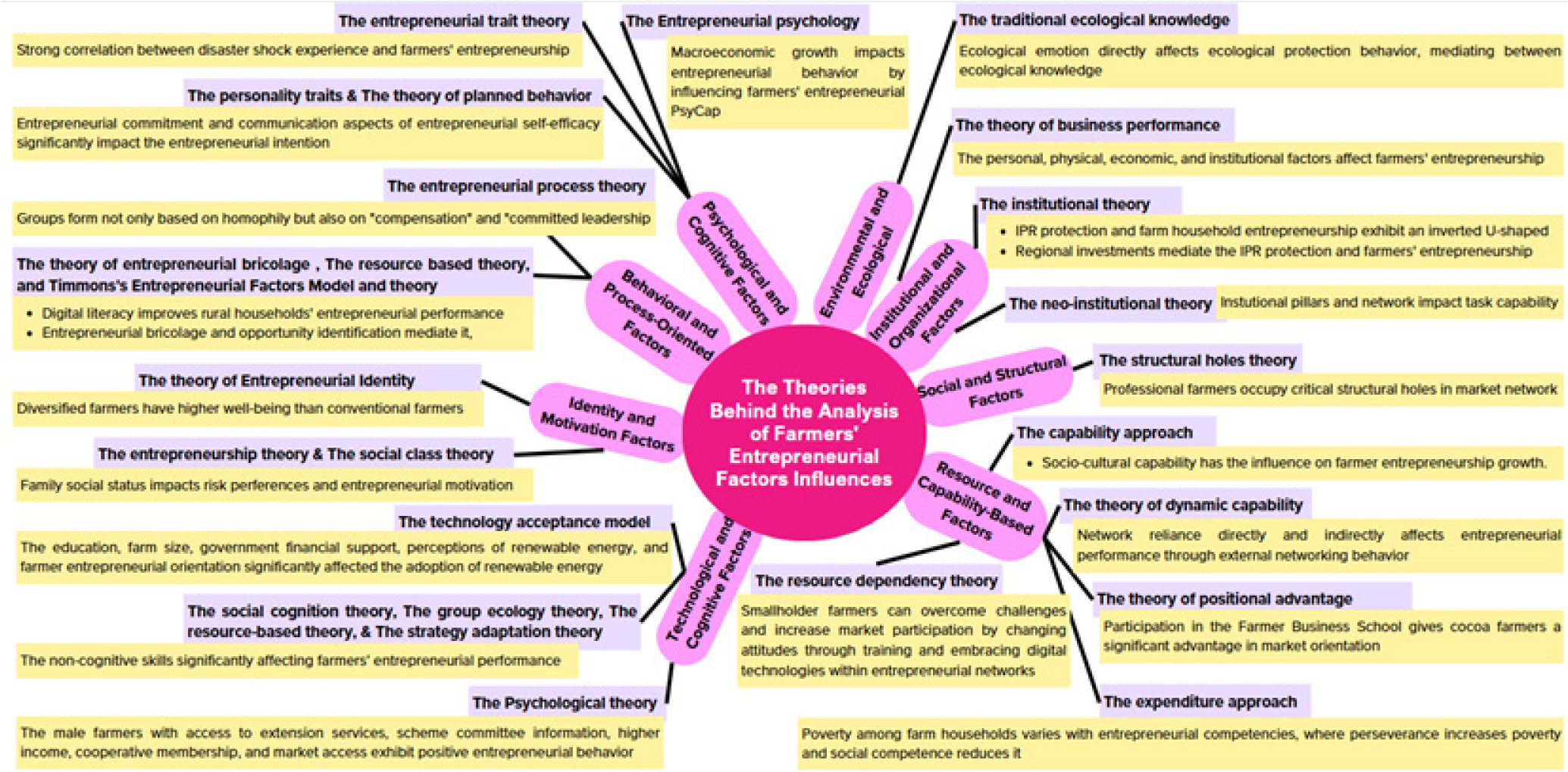
Figure 9:
The concept mapping of the theories. Source: Author’s compilation (2024).
Context
This discussion focuses on the sources, objectives, areas of focus and motivations of the reviewed articles. Bibliometric analyses in Figure 6 show the countries where studies on farmers’ entrepreneurship were conducted. The review centers on entrepreneurship, with 56 articles (Figure 10) and also includes 7 articles on agricultural production and 4 on business, highlighting the role of entrepreneurs in enhancing agricultural production. Details are depicted in Figure 10.
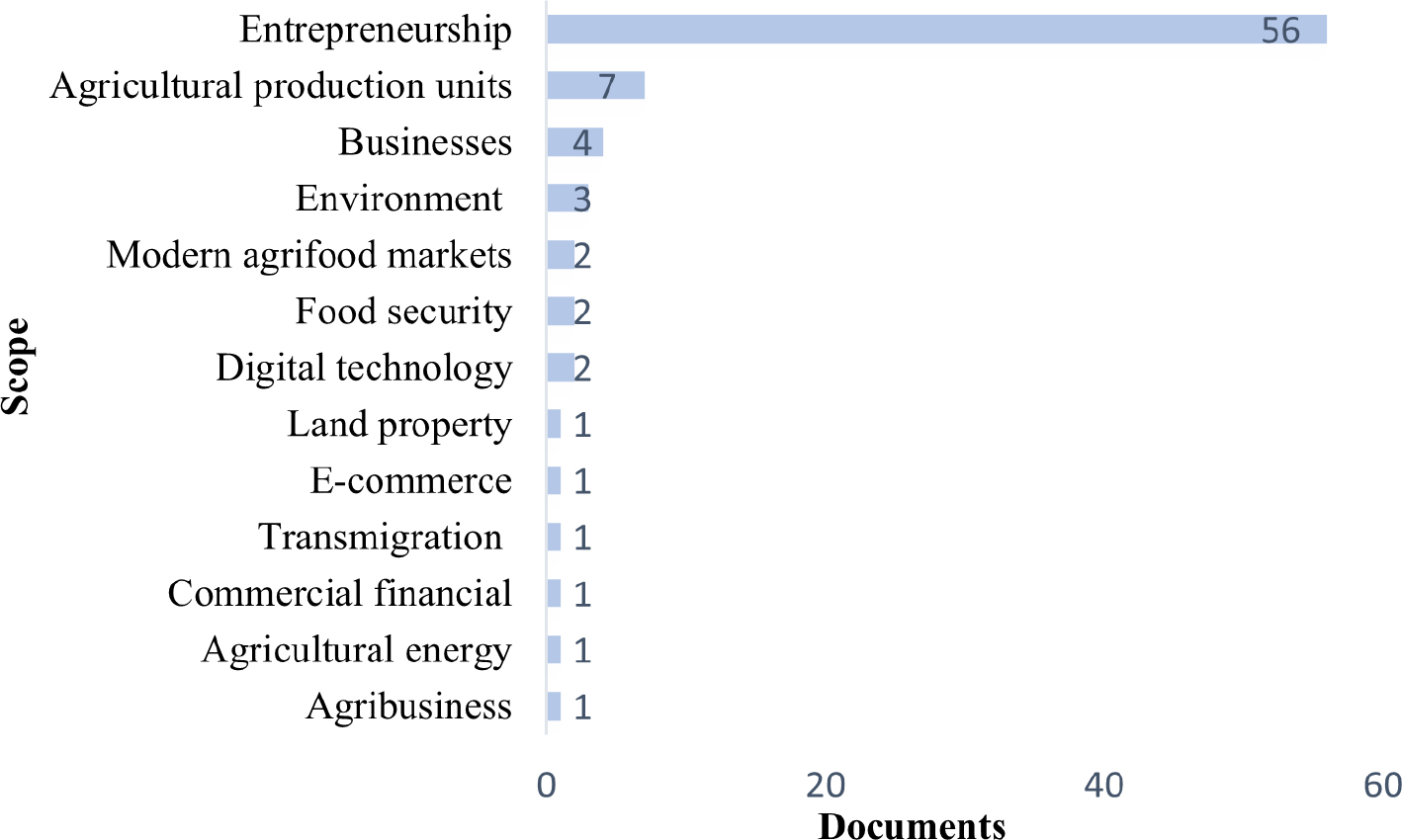
Figure 10:
Scope of the papers. Source: Author’s compilation (2024).
The characteristic and method analysis
Characteristics
This section of the TCCM technique describes the links between Dependent Variables (DV), Independent Variables (IV), Mediating Variables (MV) and Moderating Variables (MdV). Figure 11 shows this review’s framework based on literature relationships. The framework shows three sorts of relationships: IV affects DV through MV, which is controlled by MdV; IV influences DV alone; and the researchers focused on a specific DV.
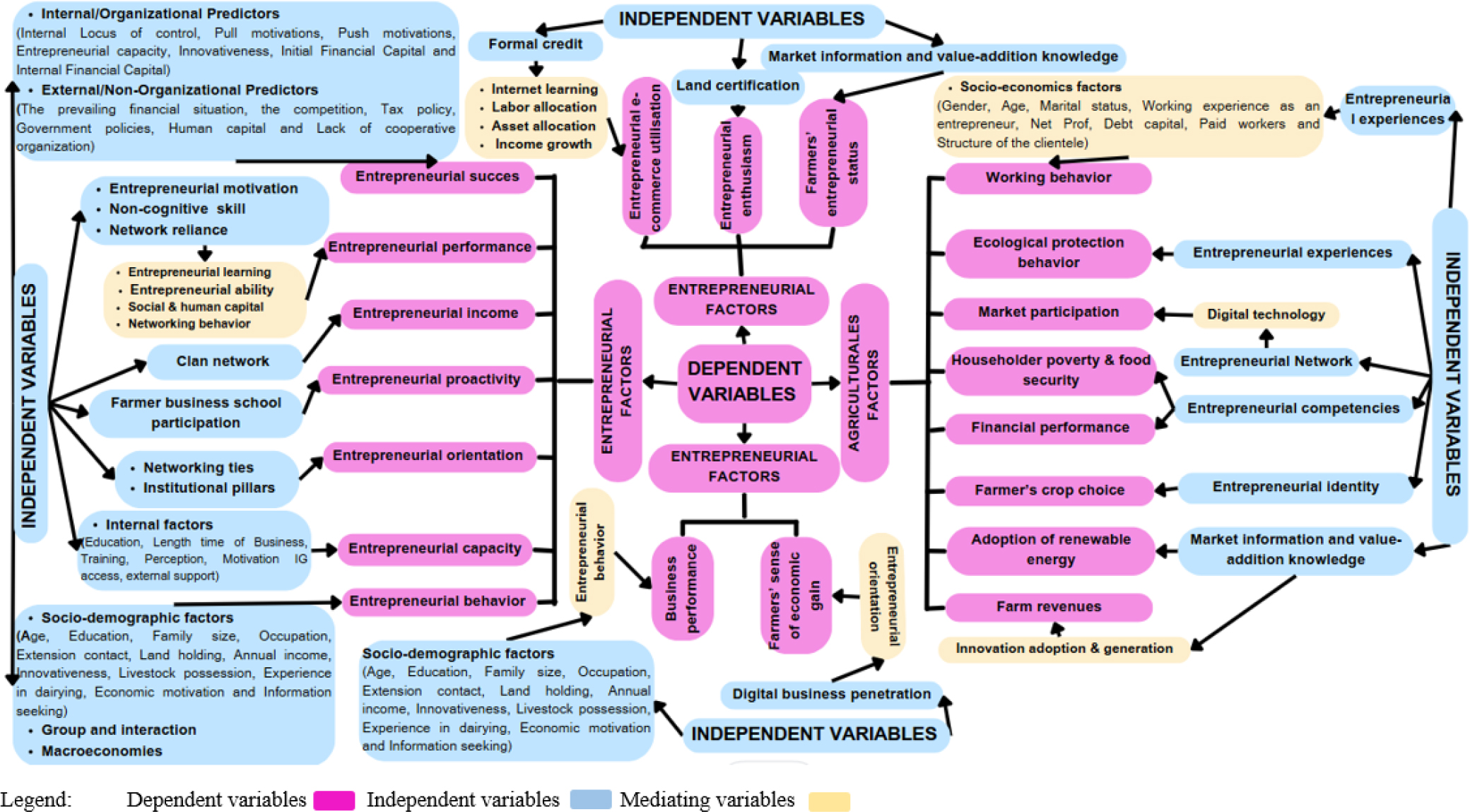
Figure 11:
Framework of the Entrepreneurship Factors. Source: Author’s compilation, (2024).
This review found entrepreneurial factors among farmers based on scholarly research. Two types of investigations were found in the reviewed literature. The first kind examined entrepreneurial and agricultural issues. Type 2 measured farmers’ entrepreneurial factors. These entrepreneurial aspects were assessed using entrepreneurial competencies,[49] education,[50] propensity,[51] ability,[52] activity,[36] attitude,[53] opportunity[54] and behavior[35] were studied. In terms of exploring the association, a priori, a positive correlation with substantial effects was observed, for example, mediating effect in[47,55,56] works, then the moderating effect was observed in[46] study.
This review examines entrepreneurial and non-entrepreneurial characteristics (such as farmer’s revenue, ecological protection behavior, household poverty and crop choice) as dependent variables to find their independent variables. Mediating variables strongly affect entrepreneurial traits. Both IV affecting DV through MV, moderated by MdV and IV influencing DV through MV were significant, demonstrating that entrepreneurship can assist farmers in overcoming production, market orientation and financial inefficiencies. According to psychology’s idea of planned behavior, the framework shows a lack of entrepreneurial attitude, knowledge and intention.[54] The performance of entrepreneurial activities starts with self-efficacy, which can be provided by the farmer’s entrepreneurial mindset, knowledge and intention.
Methods
The majority of studies (82%) utilized surveys. The sample sizes varied significantly, ranging from 56 to 39,113. However, the emphasis was on medium-sized studies, which included 101 to 500 people. Figure 12 shows many significant analyses were identified when analyzing farmer entrepreneurship. Regression analysis (OLS, Quantile and multiple) often determines farmer performance determinants observed in[57–59] studies. In some studies included in the review, structure equation modeling was used to test the relationship between entrepreneurial factors, as observed in[34,55,60] studies.[44,61,62] used probabilistic regression. Then, some authors used propensity score matching for group comparison as in[36,44,63,64] work. Basics statistics (mean, correlation, multi-stage analysis) were used by a few authors to assess the level of difference between farmers’ entrepreneurship.[49,52,60] One author used Ward’s method to access square Euclidean distance (Entrepreneurial Attitudes of Upcountry Vegetable Farmers).[53]
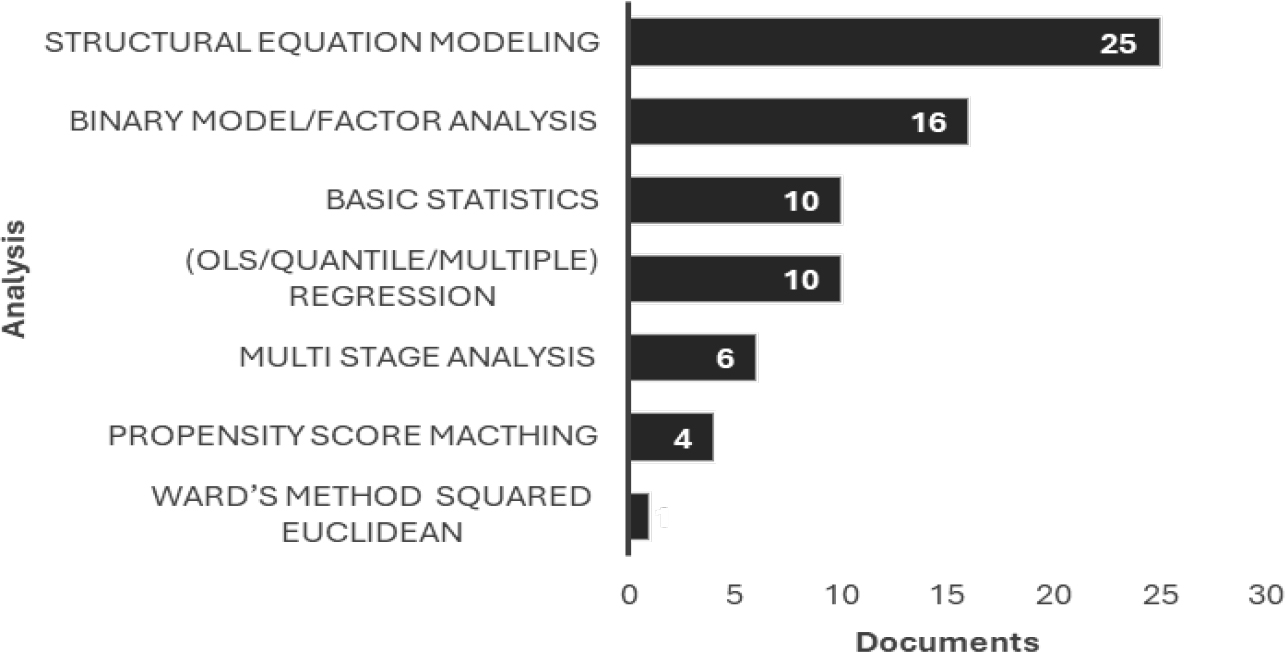
Figure 12:
Distribution of the analysis performed in the papers included.
Thematic analysis of farmers’ entrepreneurship
This thematic analysis synthesizes findings from various studies, emphasizing the interconnected factors that drive entrepreneurial behavior in the agricultural sector. Key factors include social networks, entrepreneurial orientation, financial support, education, resilience, social capital and non-cognitive skills. These elements, which are crucial in shaping farmers’ entrepreneurial actions, are clearly illustrated in the mind map (Figure 13). The map provides a visual representation of these factors, showing how they are interlinked and contribute to the development of entrepreneurial traits. For example, the adoption of new agricultural technologies and an entrepreneurial mindset are intimately linked to the impact of social networks through farmer cooperatives. These interconnected factors highlight the complexity of farmers’ entrepreneurship and the various drivers that shape their decisions and success.
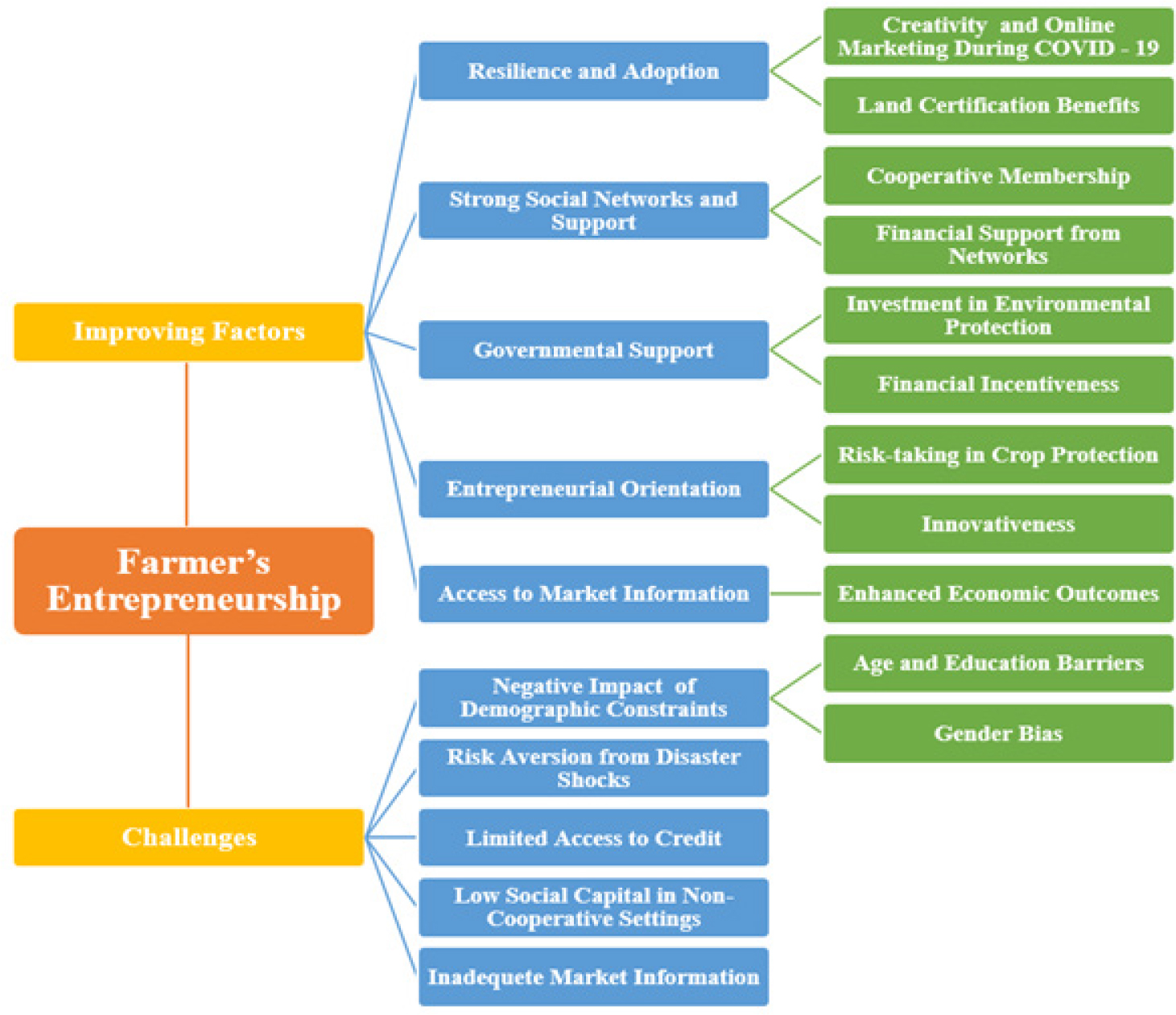
Figure 13:
The mind map of the factors influencing farmers’ entrepreneurship. Source: Author’s compilation, (2024).
Influence of Social Networks and Demographics
Farmers’ entrepreneurship depends on social networks and demographics. When friends or relatives embrace new crops or seeds and provide financial assistance or presents, farmers are more likely to follow the same.[65] Through farmer’s cooperatives, credit and market information impact market outlet decisions and improve farmers’ economic results.[66,67] According to the gender effect on farmers’ entrepreneurship, male farmers with higher incomes and cooperative membership and those with more farming experience are more entrepreneurial.[68] However, younger farmers are more entrepreneurially committed and influenced by communication and self-efficacy, while elderly farmers are more neurotic.[41]
Entrepreneurial Orientation and Technology Adoption
Entrepreneurial Orientation (EO) strongly influences farming methods. Innovativeness improves crop management and quality but hurts water harvesting.[69] Risk-taking boosts crop protection and water harvesting technology uptake but harms soil and crop management. The studies imply that entrepreneurial orientation affects several farming elements, including market outlet choice driven by inventive behavior and decision-making abilities.[66,67] Furthermore, education and entrepreneurial learning mediate motivation and performance, suggesting motivation improves learning among farmers.[70]
Economic Performance and Market Orientation
Market, entrepreneurial and innovation orientations improve farmers’ entrepreneurship’s marketing, operational and economic performance. The China-Pakistan Economic Corridor has enhanced food distribution by improving market connectivity, allowing farmers to reach new markets and realize economic opportunities.[71] Moreover, Institutional pillars and collaborative networks boost farmers’ entrepreneurial approach and economic benefits.[72]
Entrepreneurial Orientation and Technology Adoption
Entrepreneurial Orientation (EO) strongly influences farming methods. Innovativeness improves crop management and quality but hurts water harvesting.[69] Risk-taking boosts crop protection and water harvesting technology uptake but harms soil and crop management. The studies imply that entrepreneurial orientation affects several farming elements, including market outlet choice driven by inventive behavior and decision-making abilities.[66,67] Furthermore, education and entrepreneurial learning mediate motivation and performance, suggesting motivation improves learning among farmers.[70]
Economic Performance and Market Orientation
Market, entrepreneurial and innovation orientations improve farmers’ entrepreneurship’s marketing, operational and economic performance. In the China-Pakistan Economic Corridor, improving market connectivity has enhanced food distribution, allowing farmers to reach new markets and realize economic opportunities.[71] Moreover, Institutional pillars and collaborative networks boost farmers’ entrepreneurial approach and economic benefits.[72]
Financial Support, Training and Environmental Awareness
Entrepreneurship requires financial support, market data and training, then credit and market information help farmers choose better market outlets, increasing their economic outcomes.[66,67] It observed that renewable energy technology uptake is influenced by government funding and good attitudes.[44] Concerning farmers’ entrepreneurial education, higher education and involvement in educational activities are associated with modern technology adoption, entrepreneurial behavior and enhanced good behavior in environment protection by the farmers.[73,74]
Resilience and Adaptation to Challenges
Farmers adapt and overcome obstacles because it is observed that young farmers respond to COVID-19-related production, capital and marketing upheavals by being creative, founding cooperatives and using online marketing.[75] Disaster shocks first hinder entrepreneurship due to risk aversion but subsequently increase it with government help.[40]
Role of Social Capital and Cooperatives
Cooperatives with substantial social capital allow farmers to use common resources and start sustainable businesses.[76] Cooperatives lower transaction costs, improve market access and optimize resource utilization, helping farmers succeed.[54] For rural entrepreneurs to succeed, social and industrial networks increase knowledge and operational resources.[77]
Impact of Non-cognitive Skills and Competencies
Openness, conscientiousness, extroversion and agreeableness improve resource usage, market adaptability and social networking, which boosts entrepreneurial activities.[78] Social competence decreases household poverty, whereas persistence competence unexpectedly increases it.[61] Many farmers lack entrepreneurial abilities, such as risk management and production innovation, which affect agricultural businesses’ economic and operational success.[52]
CONCLUSION
This study comprehensively examined the existing literature and conducted a bibliometric analysis of the farmers’ entrepreneurship. The findings revealed that entrepreneurship plays a crucial role in facilitating the adaptation of the agricultural sector to the evolving demands of the market. This adaptation involves catering to customer needs, adopting cultivation practices tailored to specific soil types, embracing new seed varieties and integrating technological advancements in agricultural processes. However, it is important to note that the benefits of entrepreneurship in this context are primarily observed among large-scale and professional farmers. In contrast, small and medium-sized farmers face significant challenges in harnessing entrepreneurial opportunities. Furthermore, there is a noticeable dearth of research focusing on the entrepreneurial experiences of these farmers, particularly women farmers, as poverty and food insecurity are recurring aspects. Despite the considerable advancements in modern agriculture observed in developed countries, developing and underdeveloped nations continue to face significant challenges in this domain, indicating that substantial progress is still required.
To accomplish this objective, it is imperative to allocate additional research efforts toward examining smallholder farmers, with a specific emphasis on women farmers. Furthermore, it is imperative to conduct targeted research on the influence of small and medium-sized agricultural practitioners’ mindset, expertise and entrepreneurial aspirations on their ability to adapt to the evolving agricultural landscape. This includes investigating their adoption of innovative practices such as seed selection, irrigation technologies, soil management, crop mechanization and responsiveness to market demands. Additionally, it is crucial to examine the consequences of the changing agricultural environment on these farmers’ efficiency, profitability and overall economic performance. Finally, investigate the impact of government support and existing facilities on smallholder farmer sustainable entrepreneurship.
Both theoretical and analytic considerations were included in this review’s implications. The review’s theoretical dimension is evident in its exploration of numerous potential theories in the field of agricultural entrepreneurship while also acknowledging the possibility of incorporating additional theories in future research endeavors. This collection of analyses provides a framework for future studies to employ the trial-and-error methodology within a similar context. This review highlights the limited number of studies that have specifically examined interviews and focus groups using a more advanced analytical approach.
Cite this article:
Ihou AFY, Paul MJ. Entrepreneurial Landscape of Farmers: A Comprehensive Review using Bibliometric and Systematic Analysis. J Scientometric Res. 2025;14(2):399-412.
ABBREVIATIONS
| PRISMA | Preferred Reporting Items for Systematic Reviews and Meta-Analyses |
|---|---|
| TCCM | Theory, Context, Characteristic and Method |
| WoS | Web of Science |
| IoT | Internet of Things |
| AI | Artificial Intelligent |
| SLR | Systematic Literature Review |
| SO | Source of publication |
| AU | Authors |
| AU_CO | Author’s Countries |
| DV | Dependent Variable |
| IV | Independent Variable |
| MV | Mediating Variable |
| MdV | Moderator variable |
| OLS | Ordinary Least Squares |
| EO | Entrepreneurial Orientation. |
References
- Cardella GM, Hernández-Sánchez BR, Sánchez García JC. Entrepreneurship and family role: A systematic review of a growing research. Front Psychol. 2020;10:1-17. [Google Scholar]
- Li C, Murad M, Shahzad F, Khan MA, Ashraf SF, Dogbe CS, et al. Entrepreneurial passion to entrepreneurial behavior: role of entrepreneurial alertness, entrepreneurial self-efficacy and proactive personality. Front Psychol. 2020;11:1611 [PubMed] | [CrossRef] | [Google Scholar]
- Khan TH, MacEachen E, Premji S, Neiterman E. Self-employment, illness and the social security system: a qualitative study of the experiences of solo self-employed workers in Ontario, Canada. BMC Public Health. 2023;23(1):643 [PubMed] | [CrossRef] | [Google Scholar]
- Jiang X, Wu Q, Wang L, Jiang B, Ma X. Research on the impact of clan network on farmers’ entrepreneurial income—the case of China. Front Psychol. 2022;13:951421 [PubMed] | [CrossRef] | [Google Scholar]
- Otache I. Agripreneurship development: a strategy for revamping Nigeria’s economy from recession. Afr J Econ Manag Stud. 2017;8(4):474-83. [CrossRef] | [Google Scholar]
- Yoon BK, Tae H, Jackman JA, Guha S, Kagan CR, Margenot AJ, et al, et al. Entrepreneurial talent building for 21st century agricultural innovation. ACS Nano. 2021;15(7):10748-58. [PubMed] | [CrossRef] | [Google Scholar]
- Zhang Y, Yang C, Yan S, Wang W, Xue Y. Alleviating relative poverty in rural China through a diffusion schema of returning farmer entrepreneurship. Sustainability. 2023;15(2) [CrossRef] | [Google Scholar]
- Jonathan IE, Sinah M, Idowu OO, Karabo M. Effect of award, incentives and competition on entrepreneurial development among female farmers in north-west province, South Africa: a review. Int J Entrep. 2017;21(3):1-18. [CrossRef] | [Google Scholar]
- Gashi Nulleshi S, Tillmar M. Rural proofing entrepreneurship in two fields of research. Int J Entrep Behav Res. 2022;28(9):332-56. [CrossRef] | [Google Scholar]
- Zhu L, Yang C, Zhang Y, Xue Y. Using marginal land resources to solve the shortage of rural entrepreneurial land in China. Land. 2022;11(7) [CrossRef] | [Google Scholar]
- Dias CS, Rodrigues RG, Ferreira JJ. Agricultural entrepreneurship: going back to the basics. J Rural Stud. 2019;70:125-38. [CrossRef] | [Google Scholar]
- Paul J, Rosado-Serrano A. Gradual Internationalization vs Born-Global/International new venture models: a review and research agenda. Int Mark Rev. 2019;36(6):830-58. [CrossRef] | [Google Scholar]
- FAO. Brief to the state of food security and nutrition in the world. 2021 [CrossRef] | [Google Scholar]
- Kapari M, Hlophe-Ginindza S, Nhamo L, Mpandeli S. Contribution of smallholder farmers to food security and opportunities for resilient farming systems. Front Sustain Food Syst. 2023;7:1-11. [CrossRef] | [Google Scholar]
- Achmad A, Karto A, Asril A. Small business empowerment strategy in the agricultural sector through digital entrepreneurship. IJMSIT. 2024;4(2):326-35. [CrossRef] | [Google Scholar]
- Raza G, Jan K, Kazmi SZ. Agri-entrepreneurship in developing countries – a systematic review of smallholders’ constraints. J Agribus Dev Emerg Econ. 2024 [CrossRef] | [Google Scholar]
- FAO. The State of Food and Agriculture – Revealing the true cost of food to transform agrifood systems. State Food Agric. 2023:150 [CrossRef] | [Google Scholar]
- Sehgal S, Batool I. Economic development: A study of the holistic examination of sustainable agriculture’s substantial impact on developing nations. S Asian J Soc Stud Econ. 2024;21(7):241-8. [CrossRef] | [Google Scholar]
- Dhillon R, Moncur Q. Small-scale farming: a review of challenges and potential opportunities offered by technological advancements. Sustainability. 2023;15(21) [CrossRef] | [Google Scholar]
- Gomez y Paloma S, Riesgo L, Louhichi K. The role of smallholder farms in food and nutrition security. 2020 [CrossRef] | [Google Scholar]
- Zhou S, Minde IJ, Mtigwe B. Smallholder agricultural commercialization for income growth and poverty alleviation in southern Africa: A review. African journal of agricultural research. 2013;8(22):2599-608. [CrossRef] | [Google Scholar]
- Naz M, Hashmi R, Nazeer S, Raza HA, Akhtar N, Hussain Z, et al. Agripreneurship as a sustainable panacea of food security; an emerging issue. J Glob Innov Agric Sci. 2023;11(1):91-5. [CrossRef] | [Google Scholar]
- Arumugam U, Manida M. Agripreneurship for sustainable economic development in India. ComFin res [Internet]. 2023;11(4):15-23. [CrossRef] | [Google Scholar]
- Henning JI, Jammer BD, Jordaan H. Youth participation in agriculture, accounting for entrepreneurial dimensions. South Afr J Entrep Small Bus Manag. 2022;14(1):1-14. [CrossRef] | [Google Scholar]
- Katakwar S. Agri-entrepreneurship – problems and prospective in India. Int J Adv Res. 2022;10(5):563-70. [CrossRef] | [Google Scholar]
- Benjamin M. A review of the entrepreneurial behavior of farmers: an Asian-African perspective. AJAEES. 2018;22(3):1-10. [CrossRef] | [Google Scholar]
- Supriyadi D. Training and Capacity Building for Eligible SME’s Youth Entrepreneurship and Employment Support Services Programme (Yess Programme) untuk Wilayah Malang Jawa Timur. E-Coops-Day. 2023;4(1) [CrossRef] | [Google Scholar]
- Basalamah A, Syam H, Mappalotteng AM. Analysis of entrepreneurial aspects of appropriate technology training models to create farmer business opportunities. Asian J Educ Soc Stud. 2023;49(3):318-27. [CrossRef] | [Google Scholar]
- Panic N, Leoncini E, De Belvis G, Ricciardi W, Boccia S. Evaluation of the endorsement of the preferred reporting items for systematic reviews and meta-analysis (PRISMA) statement on the quality of published systematic review and meta-analyses. PLOS One. 2013;8(12):e83138 [PubMed] | [CrossRef] | [Google Scholar]
- Moher D, Liberati A, Tetzlaff J, Altman DG. Preferred Reporting Items for Systematic Reviews and Meta-Analyses: the PRISMA statement. BMJ [Internet]. 2009;339(7716):332-6. [PubMed] | [CrossRef] | [Google Scholar]
- Dervis H. Bibliometric analysis using bibliometrix an R package. J Scientometr Res. 2019;8(3):156-60. [PubMed] | [CrossRef] | [Google Scholar]
- Koo M. Systemic lupus erythematosus research: A bibliometric analysis over a 50-year period. Int J Environ Res Public Health. 2021;18(13):7095 [PubMed] | [CrossRef] | [Google Scholar]
- Riehmann P, Hanfler M, Froehlich B. Interactive Sankey diagrams. In: Proceedings of the – IEEE Symp Inf Vis INFO VIS (May). 2005:233-40. [CrossRef] | [Google Scholar]
- Li H, Qi N, Li Z, Ma W. The relationship between farmers’ entrepreneurial behavior and macroeconomics based on the probit regression model and entrepreneurial psychological capital. Front Psychol. 2022;13:954874 [PubMed] | [CrossRef] | [Google Scholar]
- Liu Z, Zhang Y, Li H. Digital inclusive finance, multidimensional education and farmers’ entrepreneurial behavior. Math Probl Eng. 2021;2021:1-13. [CrossRef] | [Google Scholar]
- Jiang X, Ma X, Li Z, Guo Y, Xu A, Su X, et al. Why do people who belong to the same clan engage in the same entrepreneurial activities?—A case study on the influence of clan networks on the content of farmers’ entrepreneurship. Front Psychol. 2022;13:873583 [PubMed] | [CrossRef] | [Google Scholar]
- Brönner M, Salah S, Lienkamp M. Production challenges in least developed countries. Challenges. 2020;11(1):1 [CrossRef] | [Google Scholar]
- Kyvik S, Reymert I. Research collaboration in groups and networks: differences across academic fields. Scientometrics. 2017;113(2):951-67. [PubMed] | [CrossRef] | [Google Scholar]
- Nisa C, rita V, Chalid DA. Impact of competition on microfinance institutions: bibliometric analysis and systematic literature review. Heliyon. 2022;8(10):e10749 [PubMed] | [CrossRef] | [Google Scholar]
- Zhang L, Gao W, Ma X, Gong R. Relationship between disaster shock experience and farmers’ entrepreneurial inclination: crisis or opportunity?. Agriculture. 2023;13(7):1406 [CrossRef] | [Google Scholar]
- Chen CC, Liang C. Evoking agriculture entrepreneurship: how younger and older farmers differ. Sustainability. 2020;12(17) [CrossRef] | [Google Scholar]
- Ji S, Zhuang J. The impact path of digital literacy on farmers’ entrepreneurial performance: based on survey data in Jiangsu Province. Sustainability. 2023;15(14) [CrossRef] | [Google Scholar]
- Janker J, Vesala HT, Vesala KM. Exploring the link between farmers’ entrepreneurial identities and work wellbeing. J Rural Stud. 2021;83:117-26. [CrossRef] | [Google Scholar]
- Wang J, Li W, ul HS, Shahbaz P. Adoption of renewable energy technology on farms for sustainable and efficient production: exploring the role of entrepreneurial orientation, farmer perception and government policies. Sustainability. 2023;15(7) [CrossRef] | [Google Scholar]
- Zhang Y, Yang C, Obuobi B, Grant M. Entrepreneurial opportunity, value evolution and organizational integration of professional farmer entrepreneurship: a multi-case comparison in China. Front Agric Sci Eng. 2023;10(1):135-48. [CrossRef] | [Google Scholar]
- Udimal TB, Liu E, Lou M. Network reliance and entrepreneurial performance, the role of external networking behaviour and entrepreneurial orientation: the case of rural farmer-entrepreneurs. Innov Manag Rev. 2021;18(3):308-30. [CrossRef] | [Google Scholar]
- Ismail IJ. Seeing through digitalization! The influence of entrepreneurial networks on market participation among smallholder farmers in Tanzania. The mediating role of digital technology. Cogent Food Agric [Internet]. 2023;9(1) [CrossRef] | [Google Scholar]
- Fitz-Koch S, Nordqvist M, Carter S, Hunter E. Entrepreneurship in the agricultural sector: A literature review and future research opportunities. Entrep Theor Pract. 2018;42(1):129-66. [CrossRef] | [Google Scholar]
- Kagbu JH. Constraints to women farmers’ entrepreneurial development in Nasarawa state, Nigeria. J Agric Ext. 2018;22(1):44-54. [CrossRef] | [Google Scholar]
- Sandhu N, Hussain J. Entrepreneurship the mediating role of finance and entrepreneurial education for small farmers in developing countries: evidence from India. Int J Entrep Behav Res. 2021;27(6):1403-22. [CrossRef] | [Google Scholar]
- Rahman S, Amit S. Implications of female farmer knowledge and participation in Bangladesh: entrepreneurial propensity and income enhancement. J Agric Crop. 2021;8(1):59-62. [CrossRef] | [Google Scholar]
- Cortés-Rodríguez CA, Martínez-Gómez G, Romo-Lozano JL, Arvizu-Barrón E. Evaluation of the entrepreneurial ability of small-scale farmers through the Rasch-Andrich model. Agriculture. 2023;13(3):1-14. [CrossRef] | [Google Scholar]
- Rosairo HS, Potts DJ. A study on entrepreneurial attitudes of upcountry vegetable farmers in Sri Lanka. J Agribus Dev Emerg Econ. 2016;6(1):39-58. [CrossRef] | [Google Scholar]
- Zhang Y, Yang C, Obuobi B, Grant MK. Entrepreneurial opportunity, value evolution and organizational integration of professional farmer entrepreneurship: a multi-case comparison in China. Front Agric Sci Eng. 2022 [CrossRef] | [Google Scholar]
- Etriya E, Scholten VE, Wubben EF, Kemp RG, (Onno)Omta SWF. The importance of innovation adoption and generation in linking entrepreneurial orientation with product innovation and farm revenues: the case of vegetable farmers in west Java, Indonesia. Int Food Agribus Manag Rev. 2018;21(7):969-88. [CrossRef] | [Google Scholar]
- Xie C, Zhu Y, Zhao Q. How digital business penetration influences farmers’ sense of economic gain: the role of farmers’ entrepreneurial orientation and market responsiveness. IEEE Access. 2020;8:187744-53. [CrossRef] | [Google Scholar]
- Sinyolo S, Mudhara M. The impact of entrepreneurial competencies on household food security among smallholder farmers in KwaZulu Natal, South Africa. Ecol Food Nutr [Internet]. 2018;57(2):71-93. [PubMed] | [CrossRef] | [Google Scholar]
- Anwarudin O, Sumardjo S, Satria A, Fatchiya A. Factors influencing the entrepreneurial capacity of young farmers for farmer succession. IJITEE. 2019;9(1):1008-14. [CrossRef] | [Google Scholar]
- Bannor RK, Ros-Tonen MA, Mensah PO, Derkyi M, Nassah VF. Entrepreneurial behaviour among non-timber forest product-growing farmers in Ghana: an analysis in support of a reforestation policy. For Policy Econ [Internet]. 2021;122(April 2020):102331 [CrossRef] | [Google Scholar]
- Saragih EC, Prihtanti TM, Yuliawati Y. The effect of farmers’ entrepreneurial behavior on business performance of PUAP program in Pandawai sub-district, east Sumba regency. Caraka Tani J Sustain Agric. 2019;34(1):43 [CrossRef] | [Google Scholar]
- Adeyonu AG, Balogun OL, Amao IO, Agboola TO. Does farmers’ entrepreneurial competencies explain their household poverty status? Evidence from rural areas of Kwara State, Nigeria. Cogent Econ Finan [Internet]. 2022;10(1) [CrossRef] | [Google Scholar]
- Suvanto H, Niemi JK, Lähdesmäki M. Entrepreneurial identity and farmers’ protein crop cultivation choices. J Rural Stud [Internet]. 2020;75(December 2019):174-84. [CrossRef] | [Google Scholar]
- Yang S, Wang H, Wang Z, Koondhar MA, Ji L, Kong R, et al. The nexus between formal credit and e-commerce utilization of entrepreneurial farmers in rural China: A mediation analysis. J Theor Appl Electron Commer Res. 2021;16(4):1-22. [CrossRef] | [Google Scholar]
- Mupfasoni B, Kessler A, Lans T, Ngenzebuke RL. Exploring entrepreneurial-group formation by smallholder Burundian farmers. J Agribus Dev Emerg Econ. 2020;10(1):85-102. [CrossRef] | [Google Scholar]
- D’Exelle B, Verschoor A. Village networks and entrepreneurial farming in Uganda. World Dev [Internet]. 2023;167:106241 [CrossRef] | [Google Scholar]
- Bowen R, Morris W. The digital divide: implications for agribusiness and entrepreneurship. Lessons from wales. J Rural Stud [Internet]. 2019;72(August):75-84. [CrossRef] | [Google Scholar]
- Ntow TK, Wongnaa CA, Nyadu-Addo R, Addison M, Awunyo-Vitor D, Abokyi E, et al. Effects of entrepreneurial behaviour on market outlets choice: evidence from rice producers in Ashanti Region, Ghana. Sustain Technol Entrep. 2023;2(2) [CrossRef] | [Google Scholar]
- Wale ZE, Unity C, Nolwazi H. Towards identifying enablers and inhibitors to on-farm entrepreneurship: evidence from smallholders in KwaZulu-Natal, South Africa. Heliyon [Internet]. 2021;7(1):e05660 [PubMed] | [CrossRef] | [Google Scholar]
- Andati P, Majiwa E, Ngigi M, Mbeche R, Ateka J. Determinants of adoption of climate smart agricultural technologies among potato farmers in Kenya: does entrepreneurial orientation play a role?. Sustain Technol Entrep [Internet]. 2022;1(2):100017 [CrossRef] | [Google Scholar]
- Yang S, Li M, Yue L, Yu L, Li W. From farmers’ entrepreneurial motivation to performance—the chain mediating effect of entrepreneurial learning and entrepreneurial ability. Sustainability. 2022;15(1) [CrossRef] | [Google Scholar]
- Sher A, Mazhar S, Abbas A, Iqbal MA, Li X. Linking entrepreneurial skills and opportunity recognition with improved food distribution in the context of the CPEC: A case of Pakistan. Sustainability. 2019;11(7) [CrossRef] | [Google Scholar]
- Parga-Montoya N, Cuevas-Vargas H. The influence of network ties on entrepreneurial orientation in Mexican farmers: an institutional perspective. RAM Rev Adm Mackenzie. 2023;24(2) [CrossRef] | [Google Scholar]
- Zaleckienė J, Vilkevičiūtė J, Linkevičiūtė S, Koloszko Chomentovska Z. Z.. Farmer’s entrepreneurship: case of Lithuania. Manag Theor Stud Rural Bus Infrastruct Dev. 2018;40(2):274-82. [CrossRef] | [Google Scholar]
- Imelda I, Hidayat R, Aritonang M. The effect of individual characteristics and entrepreneurship on rice farming performance. AGRARIS. 2022;8(1):46-57. [CrossRef] | [Google Scholar]
- Nurlaela S, Euriga E, Hermawan R, Fortuna PE. Young farmers’ entrepreneurship during the Covid-19 Pandemic. J Agribus Rural Dev Res. 2023;9(1):1-14. [CrossRef] | [Google Scholar]
- Shahab MA, Putra MA, Udin U. Strengthening social capital to increasing farmers’ entrepreneurial ability. Qual Access Success. 2022;23(187):200-8. [CrossRef] | [Google Scholar]
- Meng X, Zhang J, Sun M. An inclusive entrepreneurial path model based on rural digital entrepreneurship data in Zhejiang Province using few-shot learning. Comput Intell Neurosci. 2022;2022:8015681 [PubMed] | [CrossRef] | [Google Scholar]
- Zhang S, Zhang H, Sargani GR, Liu Q, Tang J, Zheng X, et al. Non-cognitive skills and farmers’ entrepreneurial performance: evidence from Chinese family panel studies. Agriculture. 2022;12(8):1-20. [CrossRef] | [Google Scholar]

